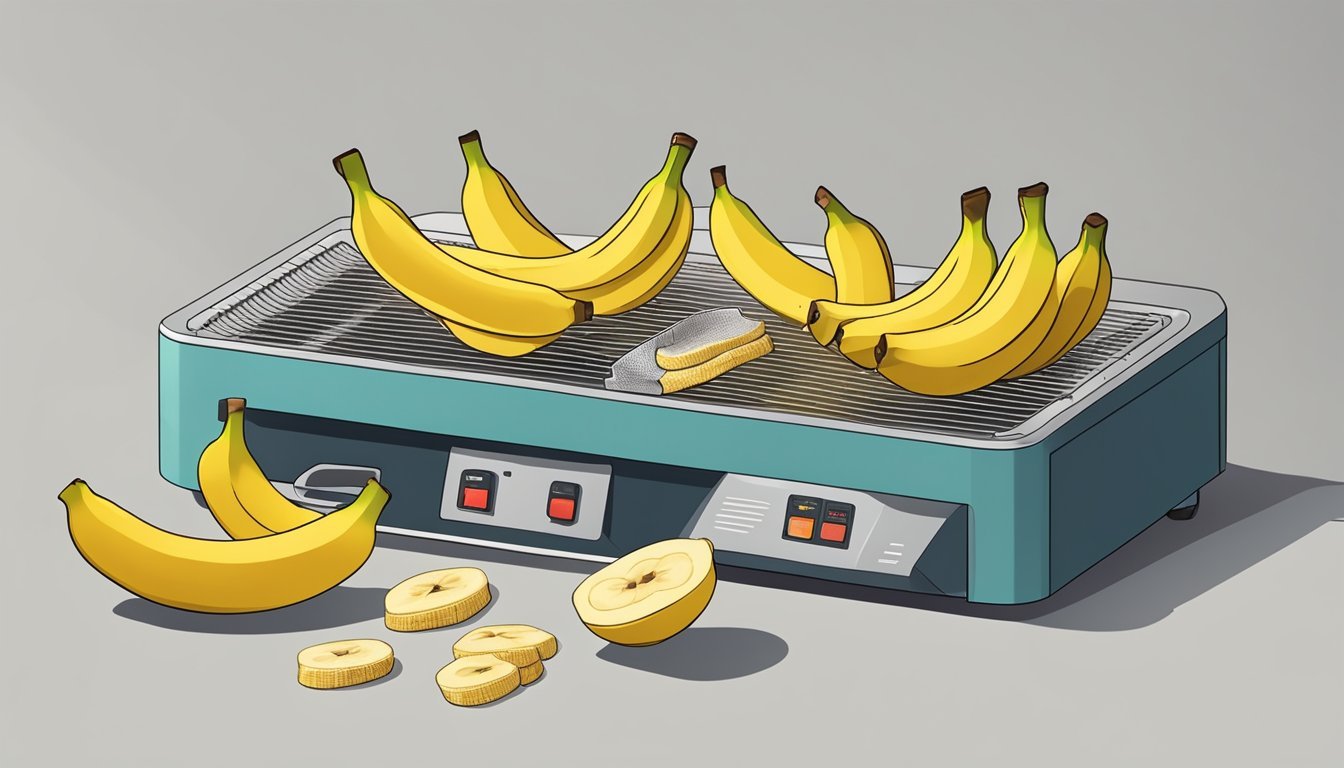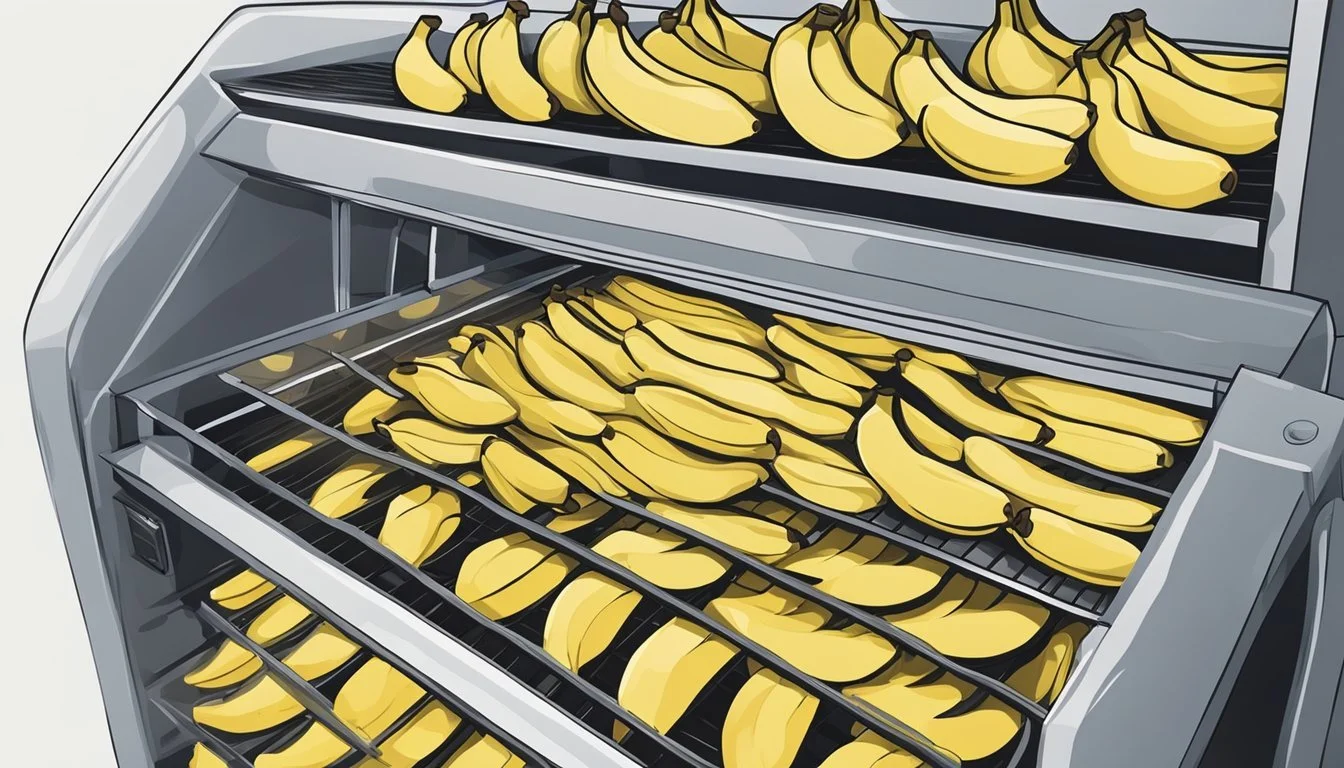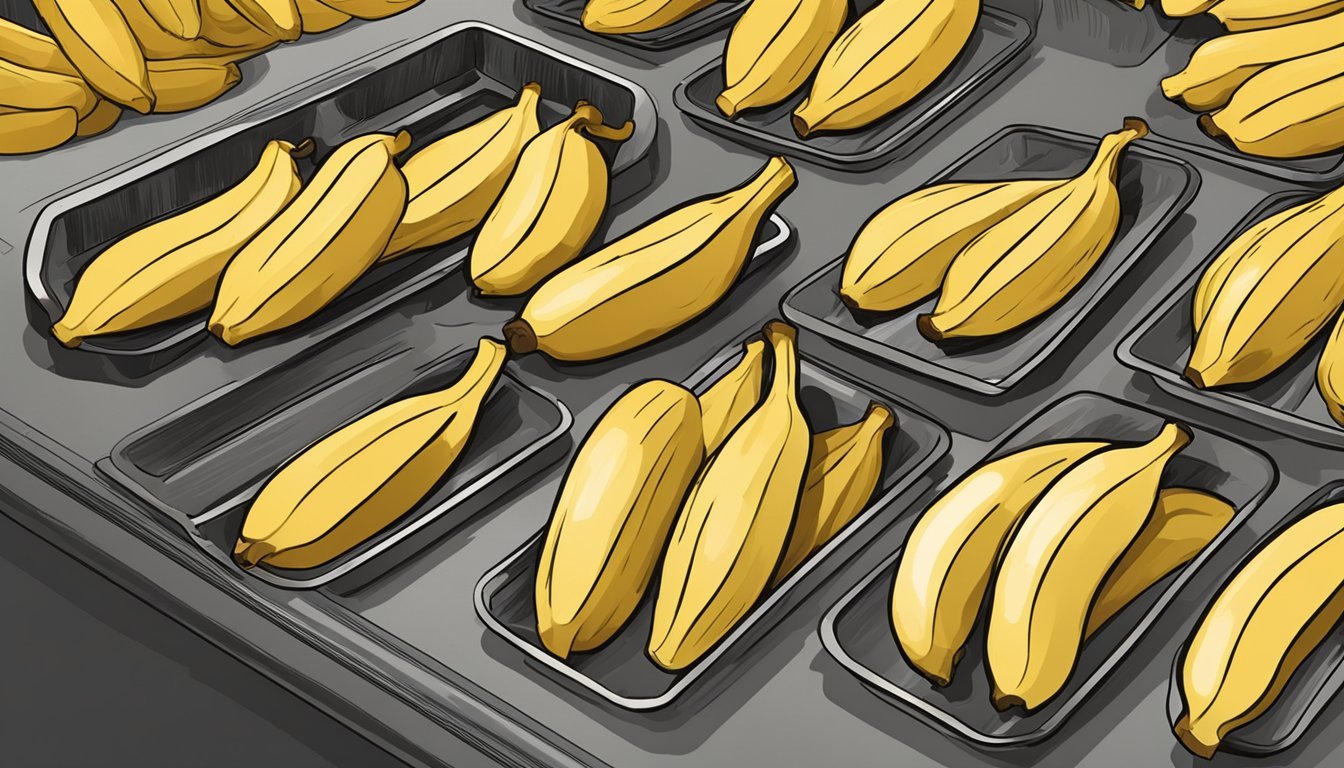How to Dehydrate a Banana
Simple DIY Drying Technique
Dehydrating bananas (how long do bananas last?) is a simple process that transforms the fruit into a convenient and healthy snack. Dehydrated bananas retain most of their nutritional value, providing a source of energy, potassium, and dietary fiber without the need for preservatives. This preservation method is especially useful for extending the lifespan of ripe bananas that might otherwise spoil.
The use of food dehydrators has popularized the practice, allowing individuals to create banana chips (how long do banana chips last?) at home with ease. These devices circulate warm air to remove moisture from the bananas, ensuring a consistent and crisp texture. Dehydrated bananas can be enjoyed on their own, added to trail mix, (how long does trail mix last?) or used in various recipes.
One can dehydrate bananas using a standard kitchen oven if a dehydrator is not available. The key is to maintain a low temperature over a prolonged period, which allows for even drying without cooking the fruit. Choosing just the right stage of ripeness can also affect the texture and taste of the final product – just-ripe bananas produce a firmer chip, while overripe bananas are better suited for creating chewier banana leather.
Benefits of Dehydrating Bananas
Dehydrated bananas offer several advantages, particularly related to preservation and nutrient concentration. As bananas dehydrate, their water content is reduced, but essential nutrients like potassium, fiber, and vitamins remain intact. Here is a closer look at the benefits:
Long-Term Storage: The moisture reduction drastically extends the shelf life of bananas, allowing them to be enjoyed for months rather than days. They are ideal for long-term storage without the need for refrigeration.
Nutrient-Dense Snack: Dehydrating bananas concentrate their natural sugars (how long does sugar last?), making them sweeter and more calorie-dense, which can provide a quick energy boost.
Fresh Banana Attributes Dehydrated Banana Attributes Higher water content Concentrated potassium levels Shorter shelf life Increased fiber content Lower sugar concentration per ounce More durable for travel and storage
Portability: Their reduced size and weight, along with their resistance to bruising, make dehydrated bananas a convenient and robust option for on-the-go snacks, suitable for hiking or as a quick midday snack.
Maintained Nutritional Value: Dehydration largely preserves the nutrition of bananas, including potassium, which aids muscle function, and fiber, beneficial for digestion. Most vitamins and minerals remain present in dehydrated bananas, providing similar nutritional benefits to fresh bananas.
Choosing the Right Bananas
When dehydrating bananas, the selection of the fruit is crucial. Bananas should be ripe, but not overly so, to ensure the best texture and sweetness in the final product.
Ripe Bananas: They should have a consistent yellow color with small brown speckles. This indicates that the banana is at peak ripeness and its sugar content is optimal for dehydration, yielding a naturally sweet result.
Choose firm banans not mushy. A firmer texture ensures that the sliced bananas will hold their shape throughout the dehydrating process.
Avoid Overripe Bananas, if there are too many brown speckles and the banana feels too soft, it may be overripe. Overripe fruit can lead to a stickier texture and a higher chance of uneven drying.
Select bananas of similar size and ripeness to promote consistent drying time and texture in the dehydrated chips or slices.
Preparation Tips for Dehydrated Banana Chips
Before you slice the bananas, ensure that they are peeled thoroughly.
Slices should be uniform, typically around 1/4 inch thick.
Remember, selecting the right banana is the foundation of successful dehydration, impacting both the flavor and quality of the dried product.
Preparation Before Dehydrating
Properly preparing bananas is crucial for yielding optimal dehydration results. The process begins with clean and even slices, followed by a pretreatment that helps retain color and texture.
Clean and Slice The Bananas
Before you slice the bananas wash them thoroughly under running water to remove any dirt or contaminants. Using a sharp knife or a mandolin, they should peel and slice bananas uniformly to ensure even drying. It's recommended to aim for thicknesses between 1/5 to 1/8 inches. A cutting board can provide a stable surface for slicing.
Equipment:
Sharp knife or mandolin
Cutting board
Steps:
Wash bananas.
Peel the bananas.
Slice them uniformly on a cutting board.
Homemade Banana Chips; Citric Acid Pretreatment
Pretreating banana slices with citric acid (how long does citric acid last?) like lemon juice not only adds a subtle flavor but also prevents browning. One can prepare a mixture of lemon juice and water in equal parts. Each fresh fruit slice should be dipped or brushed with this mixture before arranging them on a parchment paper-lined dehydrator tray or baking sheet.
Mixture:
Equal parts water and lemon juice
Application:
Combine lemon juice with water.
Dip banana slices into the mixture.
Place slices on parchment paper to ready for dehydration.
You can add oil to the lemon juice mixture in place of water for crispier homemade banana chips but try to use healthy options such as coconut oil or olive oil.
How To Dehydrate Bananas
Dehydrating fruit in a dehydrator is an efficient way to create a delicious, healthy snack. The process involves setting the right temperature, properly arranging the slices on dehydrator trays, and monitoring them to achieve even drying and perfect dehydrated fruit.
Setting the Temperature
The dehydrator should be preheated to a temperature range between 125ºF to 135ºF (52ºC to 57ºC) to ensure optimal drying without cooking the bananas. For models like the Cosori Premium food dehydrator, the temperature settings may be adjusted according to manufacturer instructions to accommodate the fruit's moisture content.
Arranging Banana Slices on Dehydrator Trays
Banana slices should be cut to approximately 1/4 inch thickness for consistent dehydration. They must be placed in a single layer on the dehydrator trays, ensuring no overlapping, and leaving a space between each dehydrating slice, to prevent uneven drying. It's beneficial to space the slices uniformly to allow air to circulate freely between them.
Monitoring the Drying Process
The drying time can vary depending on the thickness of the slices and the humidity level, typically ranging from 6 to 12 hours. It is imperative to check the banana slices periodically for their texture and flexibility. Dehydrated bananas should be leathery and slightly tacky to the touch but not sticky. Adjusting the time may be necessary to achieve the desired texture.
By adhering to these steps, one can ensure their dehydrated bananas turn out perfect.
Dehydrating Bananas in an Oven
Dehydrating bananas in an oven is a straightforward process involving specific temperature settings and preparation of your bananas on appropriate surfaces to achieve the desired texture, whether leathery or crisp.
Oven Temperature and Timing
One begins by preheating the oven to 135°F (57°C), a temperature low enough to dehydrate the slices without cooking them. To achieve ideal banana chips, timing is crucial.
Slices should be checked periodically and typically take around 6 to 8 hours to reach a leathery consistency; for crunchy banana chips, they may need to stay in the oven longer until they achieve the required hardness.
Using Baking Sheets and Wire Racks
In preparation, the chef should line baking sheets with parchment paper for easy removal of the banana slices post-dehydration. The placement is important; the slices should be laid out in a single layer without touching to ensure even dehydration.
For optimal air circulation, one may use a wire rack set on a baking sheet, allowing air to flow around the slices, which promotes even drying and can reduce the dehydration time.
Alternative Dehydrating Methods
When dehydrating bananas without a dehydrator, individuals have two effective approaches at their disposal: sun drying and using a gadget they may already have in their kitchen such as an air fryer or microwave.
Sun Drying
To utilize sun drying to dehydrate bananas, one needs a clear, sunny day with strong sunlight, as this method relies on the sun's heat to remove moisture.
The process is straightforward: they should arrange banana slices on a wire rack and coat them lightly with lemon juice to prevent browning.
The rack should then be placed in a location that receives consistent, direct sunlight for the duration of the drying process, which can vary depending on the intensity of the sun and the humidity levels of the environment. The dehydrating bananas must be covered with a net or cheesecloth to protect them from insects.
Using an Air Fryer or Microwave
An air fryer can be employed for dehydrating bananas by setting it to a low temperature, around 120-150°F (50-65°C), if available. Banana slices should be arranged in a single layer in the basket to ensure even airflow and dehydration. The drying time may vary, so they should be checked periodically.
A microwave can also be used to dehydrate bananas but it's not as efficient as other methods. Here, banana slices should be placed on a microwave-safe plate lined with parchment paper.
The microwave should be set to a defrost or 50% power setting and the bananas heated in short intervals, turning them occasionally to achieve even drying. This process requires careful attention to avoid cooking the fruit instead of dehydrating it.
Storing Homemade Banana Chips
Effective storage of dehydrated banana chips is crucial to maintain their texture and flavor. Key considerations involve the type of container, such as jars or vacuum-sealed bags, and managing humidity levels to prevent moisture reintroduction.
In Jars or Vacuum Sealing
Dehydrated banana chips can be stored in mason jars or other airtight containers to protect them from moisture and pests.
For added protection, one can use a vacuum sealer to remove all air from the storage bags. This method not only extends the shelf life of the dried banana chips but also conserves space, making it ideal for short-term storage. When using jars, the use of oxygen absorbers is effective in minimizing oxidation and preserving the quality of dried bananas.
Mason jars: Are an airtight container that ensures a tight seal.
Vacuum seal: Optimize for long-term storage and space conservation.
Shelf Life and Humidity Considerations
Managing humidity is essential when storing dehydrated banana chips. The storage environment should be cool and dry to prevent the reintroduction of moisture which can lead to spoilage.
A pantry often provides the ideal conditions with a consistent temperature away from direct light. In terms of shelf life, properly stored bananas can last for several months to a year.
However, they should be regularly checked for any signs of moisture or mold, which could indicate that the seal is not effective or that the humidity levels are too high.
Humidity: Keep below 60% relative humidity.
Shelf life: Regular checks to ensure quality over time.
Health and Nutritional Information
Dehydrated banana chips are a nutritious snack, rich in several vital nutrients. Dried fruits (how long does dried fruit last?) retain most of the nutritional value of fresh bananas, but with less water content, making them highly concentrated in calories and nutrients.
Potassium: A key mineral in bananas, potassium is known to support heart health and proper muscle function. Dehydrated banana chips are an excellent source of potassium, which is important for maintaining electrolyte balance and nerve signals.
Vitamin C: While some vitamin C is lost during the dehydration process, dried banana chips still contribute a fair amount to one's daily intake. Vitamin C is an antioxidant that helps in the protection against oxidative stress and aids in immune function.
Fiber: Dehydration does not significantly reduce the fiber content of bananas. High in dietary fiber, they aid digestion and can contribute to a feeling of fullness, which may help regulate appetite and support weight management efforts.
Minerals and Magnesium: Bananas are a good source of various minerals, including magnesium, which is essential for bone health and energy metabolism. The dehydration process preserves these minerals, making dried banana chips a nutrient-dense snack.
It's important to note that dehydrated bananas can be high in sugar, as the dehydration process concentrates natural sugars. For that reason, dried banana chips should be consumed in moderation, especially by those monitoring their sugar intake.
Creative Uses for Dehydrated Banana Chips
Dehydrated bananas offer versatile flavor enhancements and textural contrasts in various foods, from baked goods to breakfast.
Dried Fruit In Trail Mix and Cereal
Dehydrated bananas can add a sweet, chewy element to homemade trail mixes. They complement nuts (how long do nuts last?) and seeds well, providing a balanced energy source for outdoor activities. In cereal, dried chips contribute natural sweetness, reducing the need for added sugars.
Trail Mix: Combine equal parts dehydrated bananas, nuts, seeds, and chocolate chips (how long do chocolate chips last?) for an energy-boosting snack.
Cereal: Sprinkle sliced dehydrated bananas over your cereal to enhance the flavor profile.
As Toppings for Yogurt and Oatmeal
A topping of crushed dehydrated banana chips can transform the taste and texture of yogurt and oatmeal. The dried bananas add a delightful crunch and intensified banana flavor to these creamy dishes.
Yogurt: Top plain or flavored yogurt with dehydrated banana pieces, a drizzle of honey, and a sprinkle of granola (how long does granola last?).
Oatmeal: Stir dehydrated banana slices into your oatmeal, along with a spoonful of peanut butter (how long does peanut butter last?), for a satisfying breakfast.
Making Banana Bread and Smoothies
Incorporating dehydrated bananas into banana bread provides concentrated flavor and a pleasant chewiness. In smoothies, crushed dried banana chips lend a milkshake-like consistency and a robust banana taste.
Banana Bread: Mix crushed dehydrated banana slices into your batter for an intense banana flavor.
Smoothie: Blend dehydrated bananas with milk or a dairy-free alternative, adding creaminess and a rich banana essence.
Flavoring and Enhancing Dried Banana Texture
When dehydrating bananas, one can enhance both flavor and texture through the use of spices and careful control of drying time. These techniques offer a variety of tastes, from sweet and spicy to savory, and dried banana textures ranging from crunchy to chewy.
Using Cinnamon and Other Spices
To infuse dried bananas with a warm, sweet flavor, one may sprinkle cinnamon or nutmeg (how long does nutmeg last?) over the banana slices before dehydrating. The use of powdered cinnamon is particularly effective as it uniformly coats the banana slices.
Cinnamon: A light dusting can add a sweet and spicy note.
Nutmeg: A pinch can give a distinct, warm flavor.
Sea Salt: (how long does sea salt last?) For a savory twist, a very fine sprinkle can enhance the natural sweetness.
One should use spices sparingly to avoid overpowering the ripe bananas' natural flavors.
Achieving the Desired Crunchiness or Chewiness
The texture of dehydrated banana chips can range from crunchy to leathery. For crunchy banana chips, one should slice bananas thinly and dehydrate at a higher temperature for a longer period. Conversely, for chewy banana chips with a leathery texture, thicker slices and a lower temperature with a shorter dehydration time are recommended.
One may lightly coat banana slices in olive oil, coconut oil, or butter to help achieve crunchy banana chips but this should be done minimally to avoid adding excess fat.
Safety Tips for Dehydrating at Home
Safety is paramount when operating a food dehydrator. Users should place the appliance on a heat-resistant, stable surface to prevent overheating and potential hazards. When you slice the bananas use a sharp knife and exercise caution to avoid injury. It's also vital to ensure that the bananas are dehydrated at a consistent temperature and stored in an airtight container to prevent the growth of bacteria.
Best Practices
It is pretty simple to dehydrate banana chips at home. For the best results, dehydrate bananas at the appropriate temperature—usually between 125ºF to 135ºF. Uniformly sliced bananas will dry consistently. Store the dehydrated banana chips in an airtight container to preserve their texture and flavor. Remember, firm bananas and ripe bananas are best for crispy banana chips, while overripe bananas are best if you prefer your dried banana snacks a bit chewy. Dehydrated fruit is a delicious snack that can be incorporated into delicious recipes but they are packed full of sugars so should only be eaten occasionally as part of a healthy diet.




